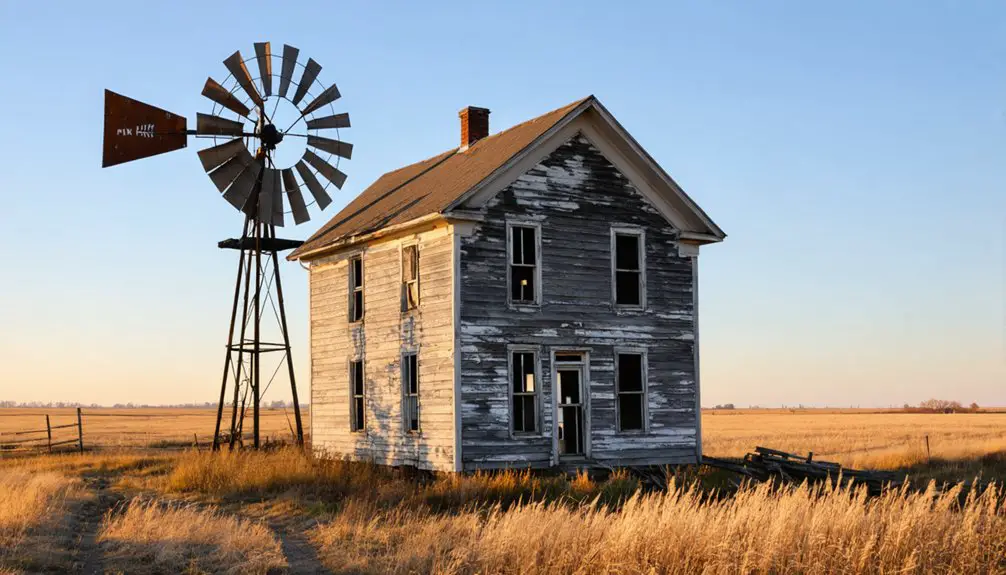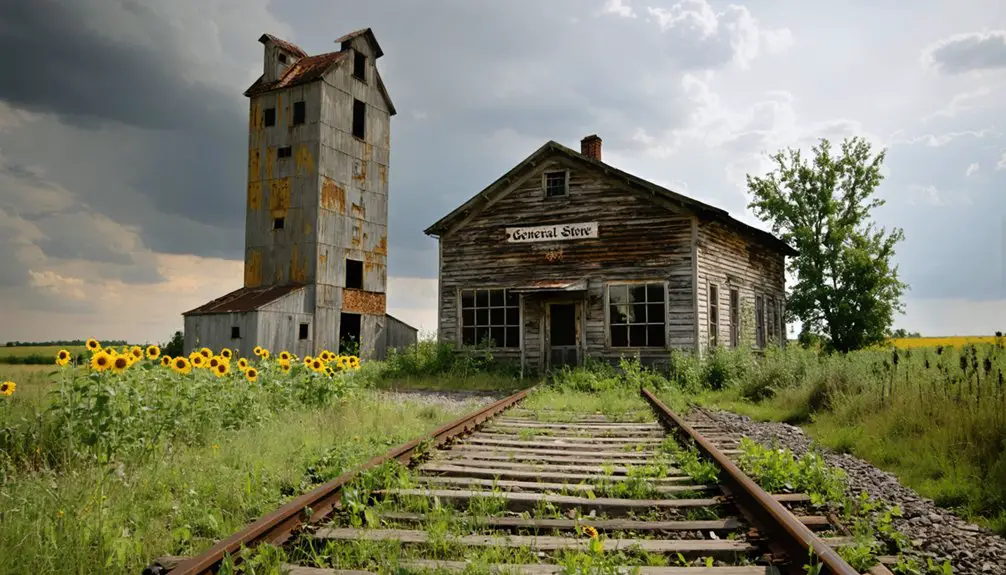You’ll find Dorothy, Minnesota’s ghostly remnants along the former Northern Pacific Railway line in Red Lake County. This once-bustling railroad town, established in 1916, thrived with a grain elevator, Catholic church, and post office serving its small but vibrant community. By 1938, only 25 residents remained, and the town’s decline accelerated after losing its post office in 1945 and railroad in 1973. Today, nature quietly reclaims the scattered foundations that hint at deeper stories waiting to be uncovered.
Key Takeaways
- Dorothy began as a railroad station in 1916 along the Northern Pacific Railway in Red Lake County, Minnesota.
- The town thrived with a grain elevator, Catholic church, and post office until economic decline began in the mid-1900s.
- By 1938, Dorothy’s population had dwindled to just 25 residents, signaling its transition toward ghost town status.
- Key closures including the post office (1945), railroad (1973), and grain elevator led to the community’s abandonment.
- The final landmark, St. Dorothy’s Catholic Church, burned down in 2014, leaving only scattered ruins and foundations.
The Birth of a Railroad Town
When the Northern Pacific Railway extended its line from Tilden Junction to Winnipeg in 1916, Dorothy emerged as a promising new railroad station in Minnesota’s Red Lake County.
You’ll find its origins firmly rooted in the railway expansion that brought new life to Section 5 of Louisville Township, where a bustling community soon took shape around the tracks.
While the post office had been operating since 1898 under Joseph H. Mathews, it wasn’t until the railroad’s arrival that Dorothy truly came into its own.
The town’s community identity centered on St. Dorothy’s Catholic Church, while a grain elevator served the local farmers’ needs.
Dorothy grew by attracting residents from nearby ghost towns like Huot who sought new opportunities.
You can trace the town’s birth to this perfect combination of spiritual, agricultural, and transportation infrastructure that defined so many Midwestern railroad towns of the early 20th century.
The railroad town’s namesake drew from the increasingly popular given name Dorothy, which was common during the early 1900s.
Life in Early 20th Century Dorothy
If you’d stepped into Dorothy during the early 1900s, you’d have found yourself in a bustling small town where the railroad station formed the heart of daily commerce as local farmers brought their grain to the elevator.
You’d likely have attended Sunday services at the striking Catholic church, where stained glass windows illuminated community gatherings and celebrations that knit the town’s 25 residents together.
Living without modern amenities, early residents relied on hand-cut ice from local lakes to keep their food and drinks cold, much like Dorothy Molter would later do at her remote resort.
The rhythm of life moved with the agricultural seasons, as wheat-laden wagons rolled through town and the whistle of trains announced another shipment heading to distant markets. During this same era, Dorothy Molter was winning the Chicago rifle championship while defying traditional expectations for young women.
Daily Railroad Station Life
As trains rumbled through the Northern Pacific Railway station in Dorothy during the early 1900s, the bustling hub served as the beating heart of this small Minnesota community.
You’d find railroad schedules dictating the rhythm of daily life, with community interactions centered around the station’s essential services.
The station’s pulse quickened with each arrival and departure:
- Farmers hauled their grain to the elevator, where it’d be loaded onto freight cars bound for distant markets.
- The postmaster sorted incoming mail and parcels while merchants restocked their shelves with fresh supplies.
- Local families gathered to welcome visitors or bid farewell to travelers, sharing news and stories near the platform.
Under the watchful eye of James Hance’s elevator, the grain business thrived as a cornerstone of Dorothy’s economic activity.
The station master orchestrated this daily dance of commerce and connection, keeping Dorothy’s lifeline to the wider world flowing smoothly. When the Northern Pacific Railroad station closed in the 1970s, it marked the beginning of the town’s decline into abandonment.
Church and Community Gatherings
Beyond the railroad station’s daily bustle, St. Dorothy’s Catholic Church stood as the town’s beating heart from 1880 until 2014. You’d find the beautiful stained-glass windows illuminating Sunday services, where families from Dorothy and nearby Huot gathered to strengthen their faith and community bonds.
Church activities weren’t just about worship – they wove the fabric of daily life. You’d see neighbors coming together for weddings, baptisms, and funerals, turning these occasions into vibrant social gatherings.
Community traditions flourished through annual services at Father Bossus’s hilltop Shrine of the Blessed Virgin, where thanksgiving prayers echoed across the prairie. In this remote setting with just 25 residents by 1938, the church served as both spiritual anchor and social hub, keeping the tight-knit Canadian immigrant community connected through decades of change. The community’s vitality began to fade when the railroad was abandoned in 1973.
Local Agricultural Trade Activities
While Dorothy’s early agricultural scene centered on wheat farming, you’d find local farmers diversifying their operations by the turn of the 20th century.
Like the notable Bonanza farms nearby, these operations had initially focused on large-scale wheat production using the latest machinery and seasonal labor.
The shift toward crop diversification and livestock integration helped farmers build resilient, independent operations that could weather market fluctuations and harsh seasons.
You’d see farm families trading at Dorothy’s bustling grain elevator, where the Northern Pacific Railway connection opened doors to broader markets after 1916.
Most families survived on forty acre plots, maintaining a careful balance of crops and livestock to sustain themselves through the year.
Local agricultural trade thrived through:
- Dairy products and livestock sales providing steady cash flow
- Multiple crop varieties including corn, oats, and potatoes reaching processing facilities
- Root vegetables and forage crops supporting expanded livestock operations
This vibrant trading system sustained Dorothy’s economy until the grain elevator’s closure in 1973, marking the end of an era in local agricultural commerce.
Economic Foundations and Infrastructure
You’ll find Dorothy’s economic heartbeat centered around its strategic position as a Northern Pacific Railway station, established in 1916-1917 to connect Tilden Junction with Winnipeg.
The railroad’s presence sparked migration from nearby settlements, particularly Huot, as families sought opportunities near this essential transportation link. Like many communities along the Red River Ox Cart Trail, Huot’s residents relocated as transportation methods evolved.
The town’s prosperity further grew with the construction of a prominent grain elevator in the late 1920s, which served as both a physical landmark and the hub of local agricultural commerce.
Railroad Hub Operations
Three distinct phases marked Dorothy’s development as a railroad hub, beginning with Northern Pacific Railway‘s expansion in 1916-17.
You’ll find that the railway infrastructure started modestly, with converted passenger cars serving as makeshift stations while supporting the region’s crucial freight operations.
Key features of Dorothy’s railroad operations included:
- A strategic grain elevator that handled agricultural shipments
- Integration with transcontinental routes connecting to Winnipeg
- Passenger services linking rural Minnesota communities
You’re looking at a reflection of freedom and mobility – Dorothy’s rails weren’t just steel tracks, they were lifelines.
The station facilitated the movement of both commodities and people, proving indispensable to Red Lake County’s development until rail service declined in the mid-20th century, ultimately facing abandonment in the 1970s.
Grain Storage Economics
As grain storage became central to Dorothy’s economic significance, farmers invested heavily in infrastructure that would shape the town’s agricultural future.
You’d find silos dotting the landscape, their $155-per-tonne construction costs justified by the promise of market timing and harvest efficiency. These towering structures weren’t just storage – they were freedom from the crushing constraints of commercial elevator bottlenecks.
Dorothy’s strategic location made it ideal for grain storage economic impact, with existing rail lines and prepared sites reducing infrastructure costs.
Farmers discovered they could spread their fixed costs by using silos for multiple crop cycles, while the town’s growing storage capacity allowed them to capitalize on price differences across seasons.
This infrastructure transformed Dorothy into a vital hub for temporal arbitrage and regional grain movement.
The Heart of Dorothy: Church and Community

Standing proudly at the heart of Dorothy’s community life, St. Dorothy’s Church began as humble masses in 1880 before growing into a vibrant parish of 65 families by 1918.
The church’s legacy lives on through the enduring community spirit that once filled its halls, even after its closure in 2001 and tragic destruction by fire in 2014.
You’ll find the church’s rich history woven into the fabric of Dorothy’s story through:
- Annual gatherings at Father Bossus’s shrine near Huot, where descendants still connect with their roots
- A succession of dedicated pastors who shaped both spiritual life and community bonds
- Beautiful stained-glass windows that served as silent witnesses to countless celebrations, marriages, and remembrances
The church wasn’t just a building – it was the beating heart of Dorothy’s rural community until the very end.
Transportation’s Golden Era
While St. Paul and Minneapolis served as major railroad hubs, it was small towns like Dorothy that truly embodied Minnesota’s transportation legacy.
You’d have witnessed incredible railroad innovation during Dorothy’s 1916-1917 establishment, as Northern Pacific Railway expanded its reach from Tilden Junction toward Winnipeg. The railway transformed Dorothy into a crucial transportation link, complete with a bustling grain elevator that connected local farmers to distant markets.
You would’ve seen James J. Hill‘s influence firsthand, as his consolidation of the Northern Pacific and Great Northern railways shaped Dorothy’s destiny.
The railroad didn’t just move goods – it moved people, ideas, and progress through the region. Dorothy’s strategic position made it a beacon of the rail era, when steam engines ruled the plains and prosperity rode the rails.
The Slow Decline: 1945-1973

When Dorothy’s post office closed its doors in 1945, you could sense the town’s impending fate. The once-bustling community, already down to just 25 residents by 1938, faced growing town isolation as essential services vanished one by one.
Small towns die slowly, their pulse fading with each shuttered storefront and departed family, until only memories remain of busier days.
You’d have witnessed the painful community disintegration through the 1950s and 60s, as families packed up and left for bigger cities, seeking new opportunities.
- The school shut down, leaving empty classrooms where children once learned
- Local businesses folded, their storefronts growing dusty and forgotten
- The grain elevator’s business dwindled, marking the end of Dorothy’s agricultural prominence
Landmarks Lost to Time
As time marched relentlessly forward, Dorothy’s cherished landmarks succumbed one by one to abandonment and decay.
You’ll find few architectural remnants of the once-vibrant community today – the iconic grain elevator, railroad station, and houses have largely vanished beneath nature’s persistent reclamation.
The Catholic church, with its beautiful stained-glass windows that once captured community memories and spirituality, stood as the town’s last major sentinel until 2014, when fire claimed its weathered walls.
You can’t see the post office that served as a hub of connection for 47 years, nor trace the railroad tracks that brought life and commerce to Dorothy’s streets.
What remains are scattered ruins and foundations, silent witnesses to a prairie town’s fleeting existence.
What Remains Today

Today, you’ll find just a handful of weathered farmhouses and deteriorating barns standing as the last physical witnesses to Dorothy’s existence.
Nature has steadily reclaimed this once-thriving settlement, with overgrown vegetation consuming abandoned structures and transforming them into haunting reminders of the past.
Time and wilderness slowly erase Dorothy’s footprints, as vines and vegetation embrace the skeletal remains of forgotten dreams.
As you explore Dorothy’s remnants, you’ll discover:
- Scattered building foundations peeking through tall grass
- Old dirt roads and rail beds cutting through the landscape
- Private properties requiring respectful distance and observation
The town’s defining landmarks have vanished – its grain elevator demolished, railroad facilities stripped away, and the historic church lost to fire in 2014.
Wildlife now roams freely through these quiet spaces where a community once flourished, creating an atmosphere that whispers stories of Minnesota’s rural heritage.
Historical Impact on Minnesota
Dorothy’s story provides a striking example of how railroad expansion shaped Minnesota’s rural development, as you’ll find its rapid rise in 1916 drew residents from established river towns like Huot into newly connected rail hubs.
You can trace the town’s brief economic prosperity through its grain elevator, Catholic church, and school – hallmark institutions of early 20th century Minnesota farming communities.
The town’s eventual decline into a ghost town after the railroad’s 1973 abandonment mirrors a broader pattern you’ll recognize across Minnesota, where countless small communities rose and fell based on their connection to essential transportation networks.
Railroad’s Role in Development
When Minnesota’s first major railroad line reached St. Paul in 1862, you’d witness the dawn of unprecedented railroad expansion that would reshape the state’s landscape.
As rail networks spread in a radial pattern from St. Paul, they created lifelines for small settlements like Dorothy, defining their existence and eventual ghost town dynamics.
You’ll discover how these iron horses transformed Minnesota’s frontier through:
- Eastern financiers’ investments that funded the crucial infrastructure
- The creation of settlement streams from river ports into untamed prairies
- The integration of agriculture, mining, and lumber industries into a unified economic system
James J. Hill’s visionary expansion of rail lines connected Dorothy and countless other towns to eastern markets, though not all would survive.
The railroads weren’t just tracks and trains – they were the arteries of freedom, allowing settlers to forge new lives in Minnesota’s vast interior.
Economic Rise and Fall
The early 20th century marked a time of boundless optimism for the agricultural hub of Dorothy, Minnesota.
You’d have witnessed rural resilience at its finest, as the town flourished with its grain elevator, Catholic school, and bustling post office serving the farming community.
But Dorothy’s story reveals how quickly fortunes can change. The town’s inability to achieve economic diversification proved disastrous when modern shifts began challenging its agricultural foundation.
You can trace its decline through pivotal losses: the post office’s closure in 1945, the railroad’s abandonment in 1973, and the shuttering of its essential grain elevator.
Each blow pushed more residents to seek opportunities elsewhere, until Dorothy transformed from a symbol of Minnesota’s farming prosperity into a ghost town – a stark reminder of how infrastructure and economic adaptability shape rural destinies.
Small Town Migration Patterns
Throughout Minnesota’s history, you’ll find that small towns experienced dramatic demographic shifts shaped by waves of immigration and cultural preservation. In places like Dorothy, these patterns reflected broader changes as ethnic groups carved out their own spaces in the Minnesota landscape.
- Norwegian immigrants established tight-knit cultural enclaves around Lutheran churches, preserving their regional dialects and customs from the old world.
- Mexican and Tejano workers created migrant colonies that transformed into permanent communities, despite facing significant challenges in housing and employment.
- European settlers, drawn by the Homestead Act’s promise of land ownership, formed distinct ethnic communities that shaped small town identities.
Today’s small town migration patterns tell a different story, as aging populations and economic shifts continue to reshape these once-thriving cultural communities.
Exploring Dorothy’s Ghost Town Legacy
Nestled within the rolling landscapes of Red Lake County, Dorothy’s ghost town legacy tells a poignant story of rural America’s changing fortunes.
If you visit today, you’ll find little trace of the once-bustling railroad hub that sprouted from the 1898 establishment of its post office.
As you walk through the overgrown remnants, you can imagine the vibrant community that thrived here until 1973.
The beautiful St. Dorothy’s Catholic Church, with its stained-glass windows, stood as the town’s cultural anchor until its tragic burning in 2014.
Now, the ghost town’s empty grounds whisper tales of grain elevators, railway stations, and a close-knit population of 25 that called this place home.
Dorothy’s transformation from a promising settlement to abandoned ruins mirrors countless similar stories across America’s heartland.
Frequently Asked Questions
Were There Any Notable Crimes or Mysteries in Dorothy’s History?
You won’t find any unsolved mysteries or historical crimes in Dorothy’s documented past. The town’s eerie reputation comes purely from its abandoned state and natural decay over time.
What Happened to the Families Who Lived in Dorothy?
You’ll find most families dispersed to larger towns when economic decline hit Dorothy hard – first after the post office closed in 1945, then massively after the railroad’s removal in 1973.
Are There Any Known Burial Grounds or Cemeteries Near Dorothy?
While there’s no record of burial grounds within Dorothy itself, you’ll find most former residents were likely laid to rest in surrounding Red Lake County church cemeteries after the town’s Catholic church burned in 2014.
Did Any Famous People Ever Visit or Live in Dorothy?
You won’t find any famous visitors or notable historical figures who lived in Dorothy. Beyond Joseph H. Mathews, the first postmaster, the town’s remote location and brief existence attracted only regular townspeople.
What Natural Disasters or Severe Weather Events Affected Dorothy?
Picture the quiet prairie town standing strong – you won’t find records of flooding impacts or tornado damage here. The only notable weather event was a 2014 fire that claimed the abandoned church.
References
- https://www.onlyinyourstate.com/trip-ideas/minnesota/spooky-small-town-mn
- https://quickcountry.com/minnesota-ghost-towns/
- https://en.wikipedia.org/wiki/Dorothy
- https://www.onlyinyourstate.com/experiences/minnesota/abandoned-railroad-town-mn
- https://thievesriver.com/blogs/articles/ghost-towns-in-minnesota
- http://wikimapia.org/13663040/Dorothy-Minnesota-Ghost-Town
- https://www.rootbeerlady.com/dorothy/
- https://en.wikipedia.org/wiki/Dorothy_Molter
- https://www.rootbeerlady.com/museum/
- http://www.redlakecountyhistory.org/louisville.htm



